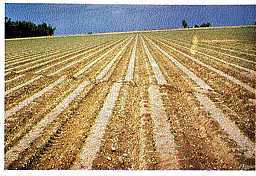Seismic Waves Using seismic information to deduce the Earth's structure
They are caused
when rock breaks or is deformed. When this happens, waves of energy are
released and if strong enough, cause the surface of the Earth to tremble
noticibly. Many Earth tremors are of such low magnitude they are not noticed
by us. The classic, standard model of seismic waves dictates that seismic waves occur along fault lines. Why do the plates slip? Great stress is
placed on rocks along these boundaries. If the stress becomes too great,
the tectonic plates slide along each other
or slip under each other, releasing the built-up energy in waves. Faults
are weak and only need a small stress to cause them to move. Far below the surface of the Earth, temperatures and pressures are tremendous. These quantities can become so great that one mineral can be transformed into a new, denser mineral. If this process happens over a large enough area, the old area loses its base of support and drops down. This action would cause tremors. The 'slash' across the crop rows in the photo on the right show where a probably fault line lies. (Note how the crop rows are shifted) Seismic wavesTypes of Seismic waves There are several types of seismic waves. They are split into two main types:
and Locating an Earthquake EpicentreTo find the epicenter of an Earthquake you need to use at least three seismograms. Each earthquake centre can work out how long it took for the P waves to reach the detector by looking at the difference in the time it took for the P and S waves to arrive. From that information they can then work out how far away the epicentre is. But they do not know the direction that the vibrations travelled from. So they use the information from three centres to pinpoint the only point the vibrations could have eminated from. Where the three cross is the epicentre From seismograms you need to be able to determine the arrival times of the p-waves and the s-waves. (Remember that p-waves will always reach the seismograph first because they travel faster and that s-waves only travel through solids). Then calculate the time difference of arrival of the two wavetypes and use that and the speeds of the waves to work out how far away the epicentre must be.
L. Jones (September 2002) - revamped October 2013 |
Follow me...
|


 One possible
cause for earthquakes lies deep under the surface.
One possible
cause for earthquakes lies deep under the surface. 



